Submitted:
27 March 2024
Posted:
28 March 2024
You are already at the latest version
Abstract
Keywords:
1. Introduction
2. Data and Methods
2.1. Overview of the Study Area
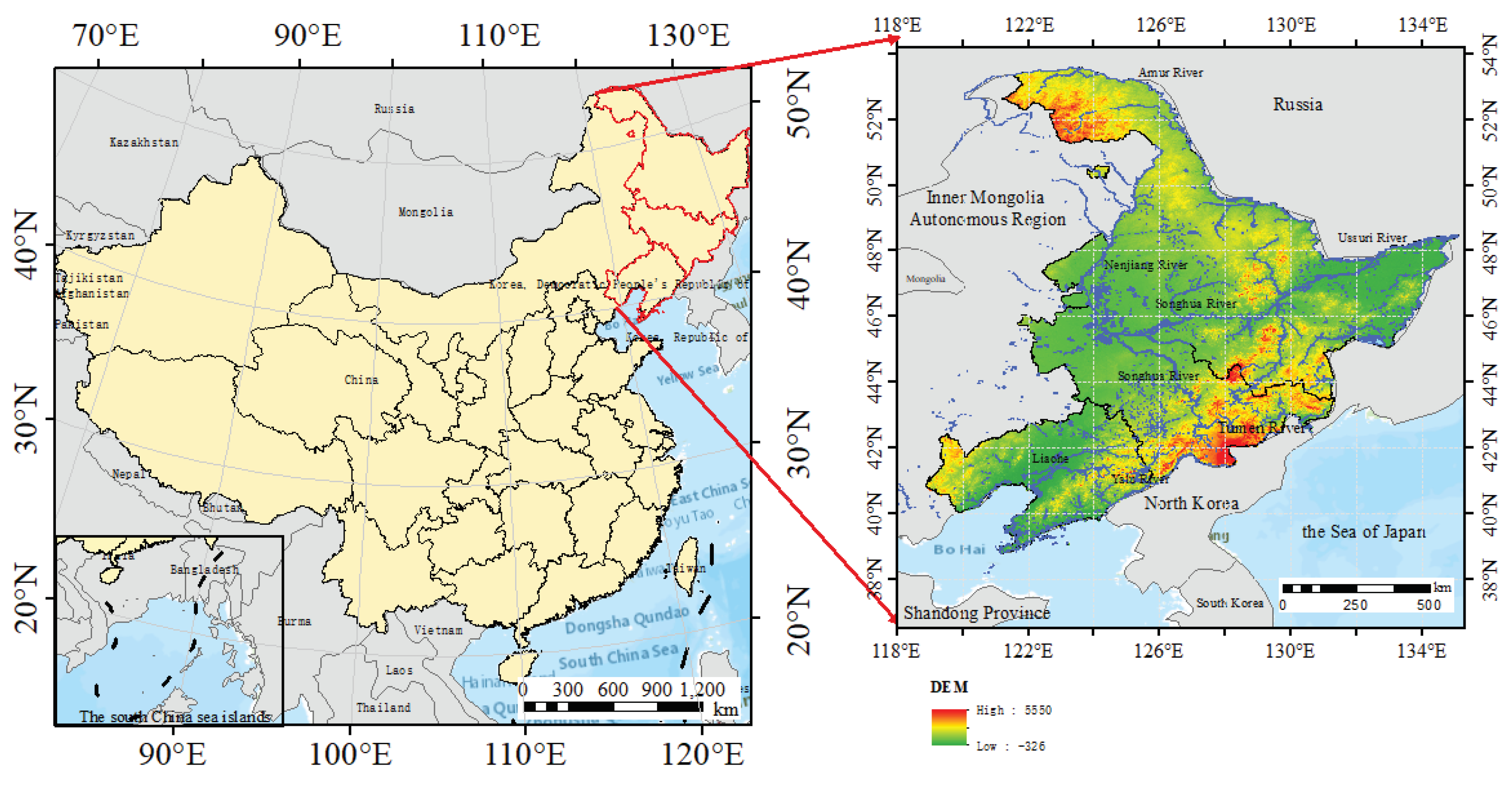
2.2. Data Processing
2.2.1. GRACE Data
- The GRACE gravity satellite's provided spherical harmonic coefficients are employed for calculating the Earth's surface time-varying gravity field, delineated as follows:
2.2.2. Precipitation Data
2.2.3. Data on water use efficiency variables
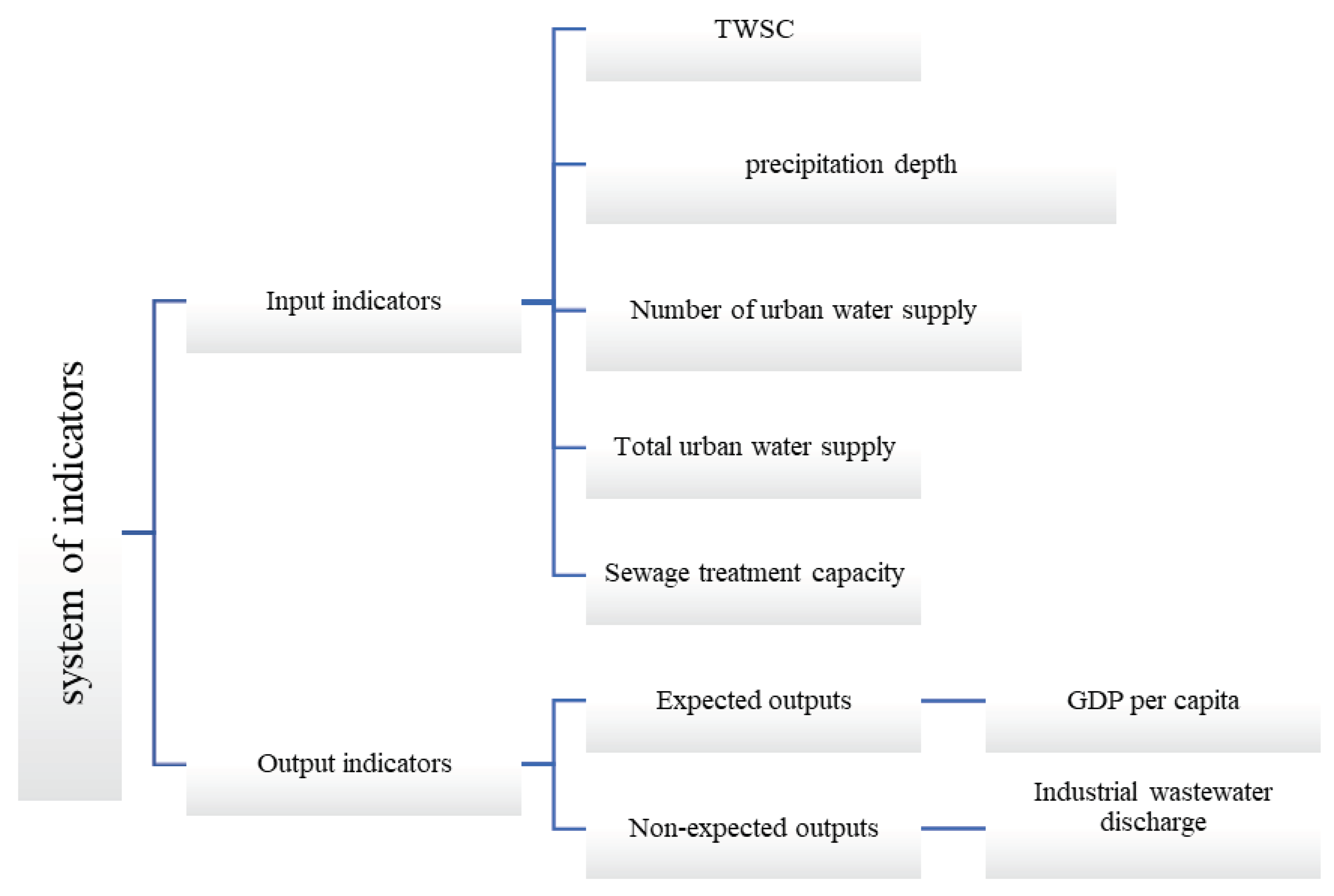
2.2.4. Impact Factor Data
2.3. Research Methodology
2.3.1. Super-SBM Modelling
2.3.2. Malmquist Exponential Modelling
2.3.3. Spatial Autocorrelation
3. Spatial and Temporal Analysis of Terrestrial Water Reserves
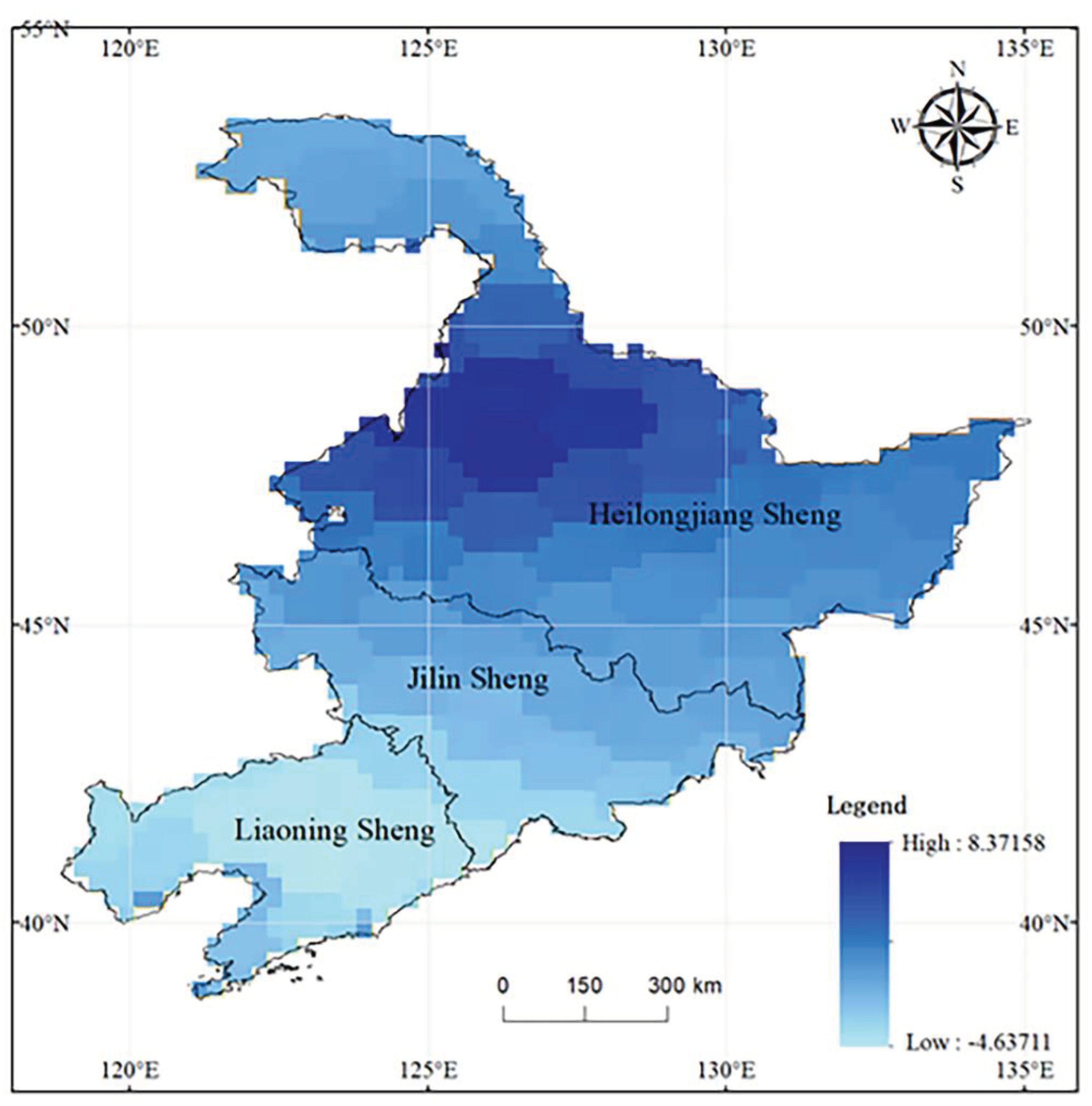
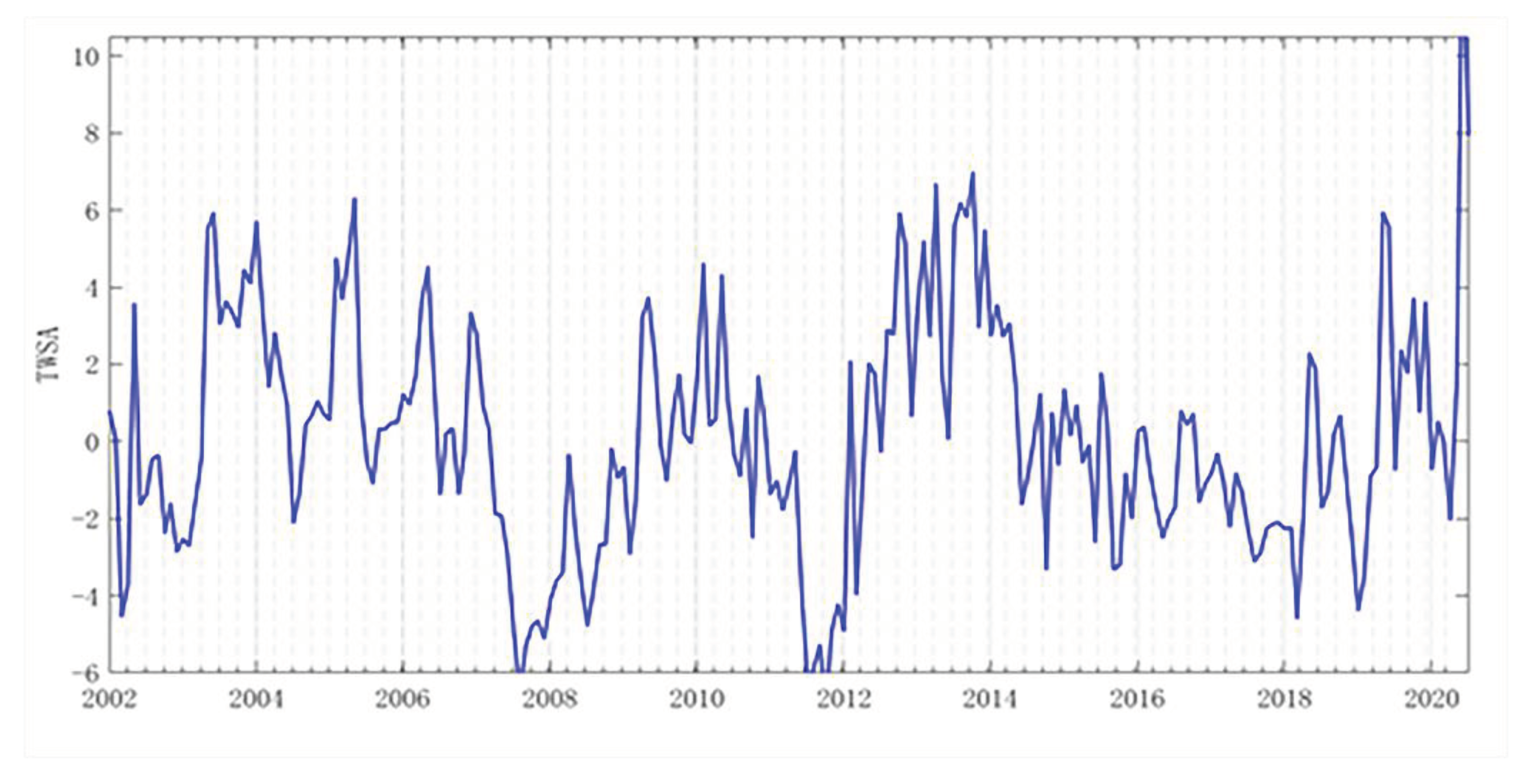
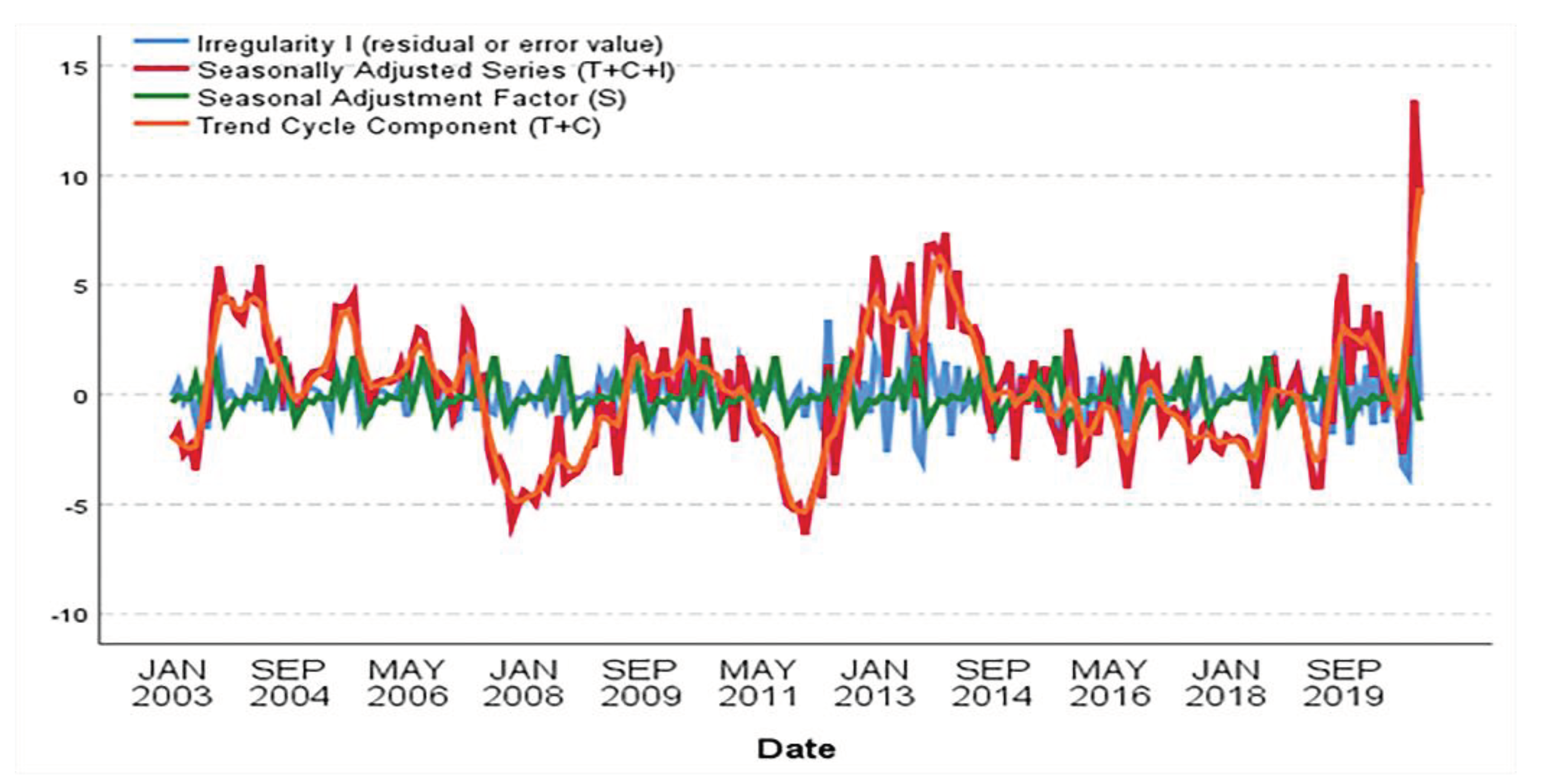
4. Water Use Efficiency Analysis
4.1. Static Water Use Efficiency Analysis
| Year (years) | 2003 | 2004 | 2005 | 2006 | 2007 | 2008 | 2009 | 2010 | 2011 | Total |
| Number of valid values (in pieces) | 16 | 16 | 11 | 10 | 3 | 6 | 22 | 13 | 12 | 248 |
| Year (years) | 2012 | 2013 | 2014 | 2015 | 2016 | 2017 | 2018 | 2019 | 2020 | |
| Number of valid values (in pieces) | 13 | 12 | 14 | 18 | 17 | 14 | 18 | 17 | 16 |
| Region | Mean | Ranking | Region | Mean | Ranking |
| Panjin | 1.13 | 1 | Fuxin | 0.77 | 18 |
| Heihe | 1.11 | 2 | Hegang | 0.76 | 19 |
| Daqing | 1.09 | 3 | Suihua | 0.74 | 20 |
| Liaoyuan | 1.02 | 4 | Jiamusi | 0.72 | 21 |
| Baishan | 1.02 | 5 | Jixi | 0.71 | 22 |
| Yichun | 0.98 | 6 | FUshun | 0.70 | 23 |
| Baicheng | 0.95 | 7 | Shenyang | 0.69 | 24 |
| Songyuan | 0.92 | 8 | Dandong | 0.69 | 25 |
| Chaoyang | 0.90 | 9 | Anshan | 0.69 | 26 |
| Tonghua | 0.85 | 10 | Yingkou | 0.68 | 27 |
| Dalian | 0.83 | 11 | Jinzhou | 0.66 | 28 |
| Tieling | 0.83 | 12 | Huludao | 0.63 | 29 |
| Benxi | 0.82 | 13 | Mudanjiang | 0.63 | 30 |
| Shuangyashan | 0.82 | 14 | Changchun | 0.61 | 31 |
| Siping | 0.81 | 15 | Jilin | 0.54 | 32 |
| Qitaihe | 0.79 | 16 | Harbin | 0.52 | 33 |
| Liaoyang | 0.77 | 17 | Qiqihar | 0.44 | 34 |
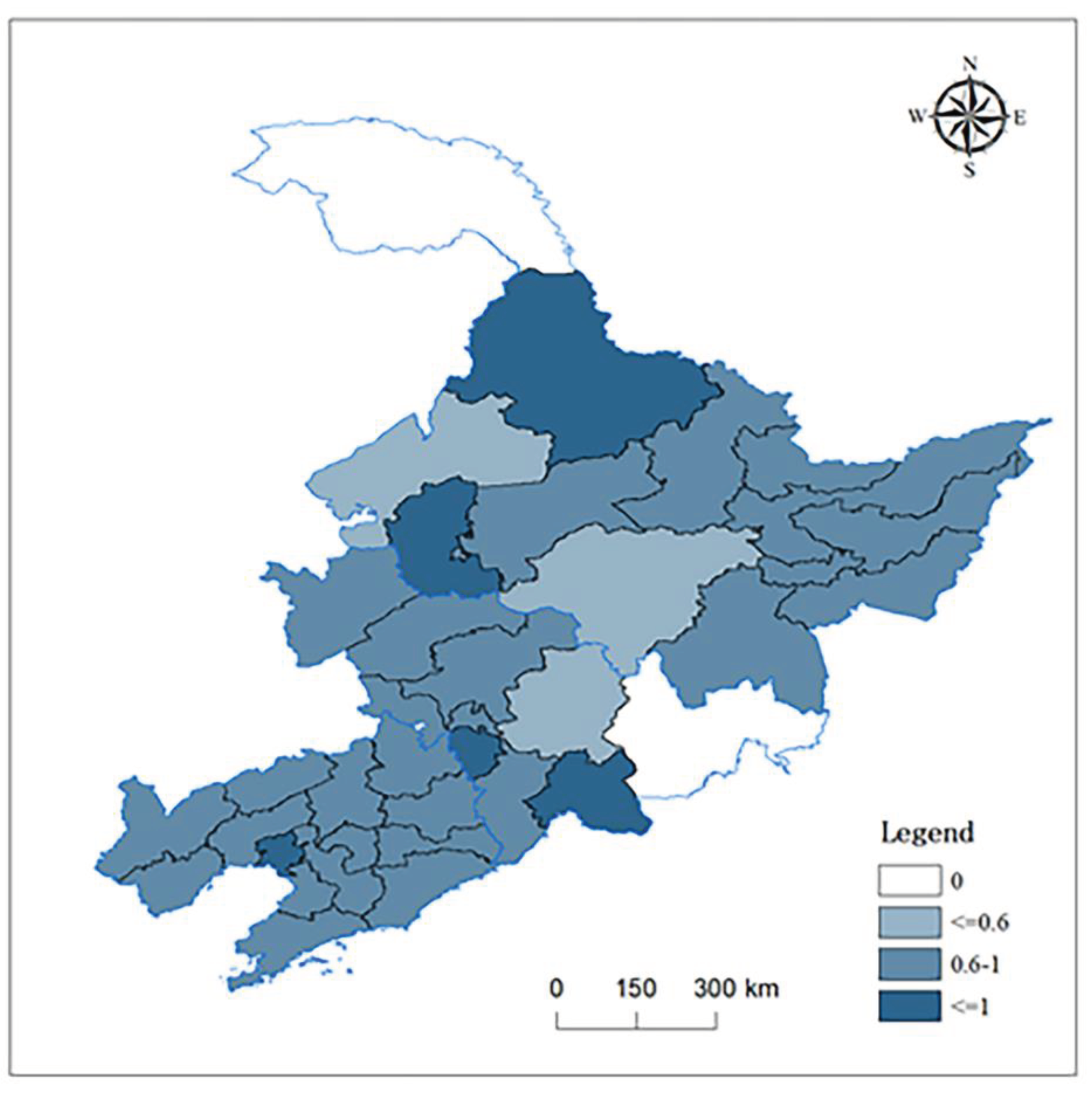
4.2. Dynamic Water Use Efficiency Analysis
| Year(Year) | 2003-2004 | 2004-2005 | 2005-2006 | 2006-2007 | 2007-2008 | 2008-2009 | 2009-2010 | 2010-2011 | 2011-2012 |
| Number of effective efficiency values (pcs) | 24 | 23 | 22 | 22 | 17 | 18 | 29 | 29 | 24 |
| Year(Year) | 2012-2013 | 2013-2014 | 2014-2015 | 2015-2016 | 2016-2017 | 2017-2018 | 2018-2019 | 2019-2020 | Total |
| Number of effective efficiency values (pcs) | 17 | 19 | 22 | 7 | 16 | 21 | 16 | 7 | 333 |
| Year | EFFCH | TECH | PECH | SEC | M index |
| 2003-2004 | 0.953 | 1.089 | 1.001 | 0.953 | 1.038 |
| 2004-2005 | 0.98 | 1.062 | 0.976 | 1.004 | 1.04 |
| 2005-2006 | 1.019 | 1.006 | 1.02 | 1 | 1.025 |
| 2006-2007 | 0.766 | 1.371 | 0.957 | 0.8 | 1.05 |
| 2007-2008 | 1.262 | 0.777 | 0.997 | 1.266 | 0.981 |
| 2008-2009 | 1.025 | 0.963 | 1.045 | 0.981 | 0.987 |
| 2009-2010 | 0.953 | 1.123 | 0.983 | 0.969 | 1.07 |
| 2010-2011 | 0.951 | 1.194 | 0.997 | 0.954 | 1.136 |
| 2011-2012 | 0.942 | 1.099 | 0.997 | 0.945 | 1.035 |
| 2012-2013 | 1.012 | 0.974 | 1.008 | 1.004 | 0.985 |
| 2013-2014 | 1.04 | 1.013 | 0.961 | 1.082 | 1.054 |
| 2014-2015 | 0.988 | 1.087 | 0.977 | 1.011 | 1.074 |
| 2015-2016 | 1.13 | 0.74 | 1.052 | 1.074 | 0.837 |
| 2016-2017 | 1.018 | 0.964 | 0.999 | 1.019 | 0.981 |
| 2017-2018 | 1.034 | 1.002 | 0.992 | 1.043 | 1.037 |
| 2018-2019 | 0.988 | 1.016 | 0.985 | 1.003 | 1.004 |
| 2019-2020 | 0.986 | 0.923 | 0.99 | 0.996 | 0.911 |
| mean | 0.998 | 1.014 | 0.996 | 1.002 | 1.012 |
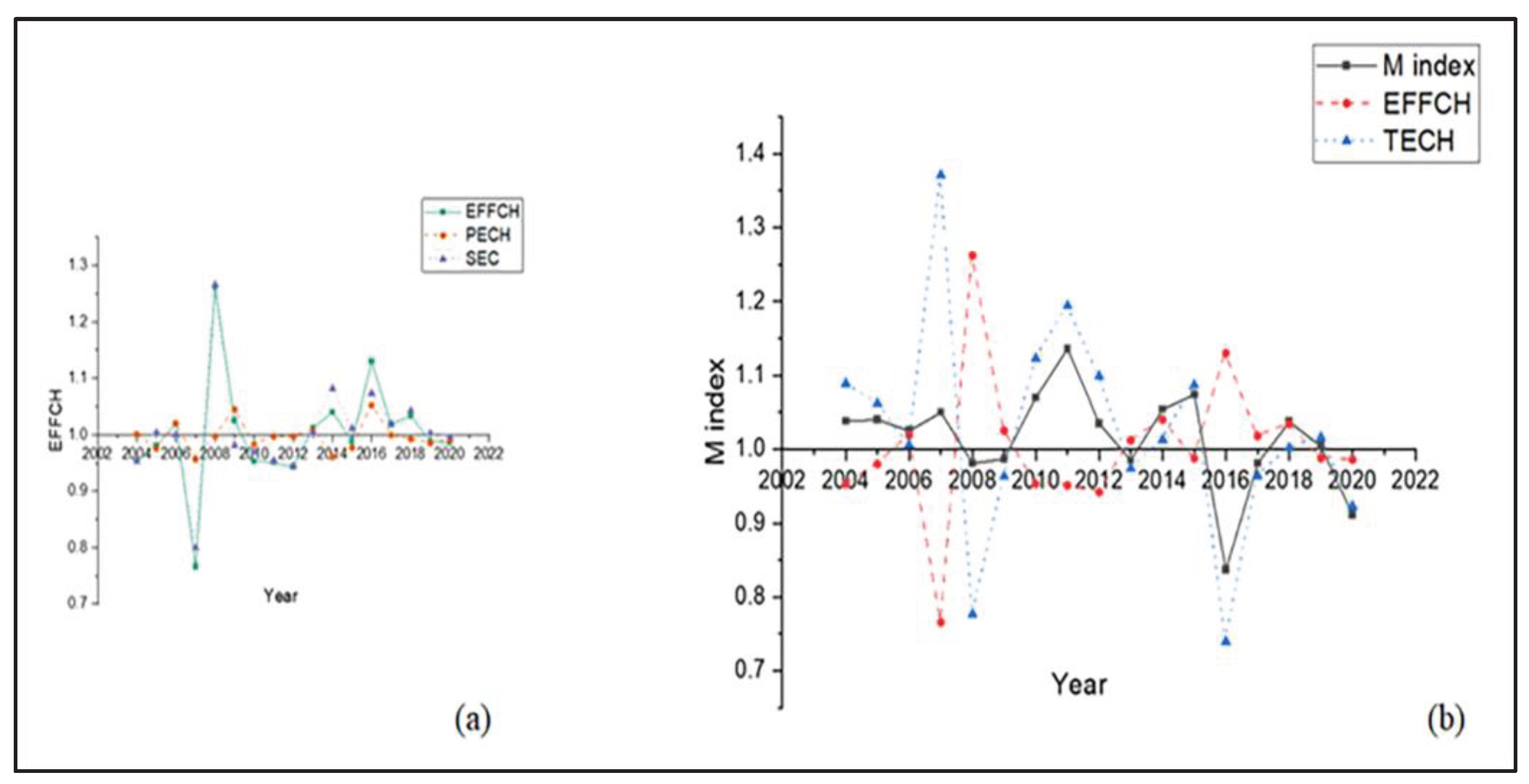
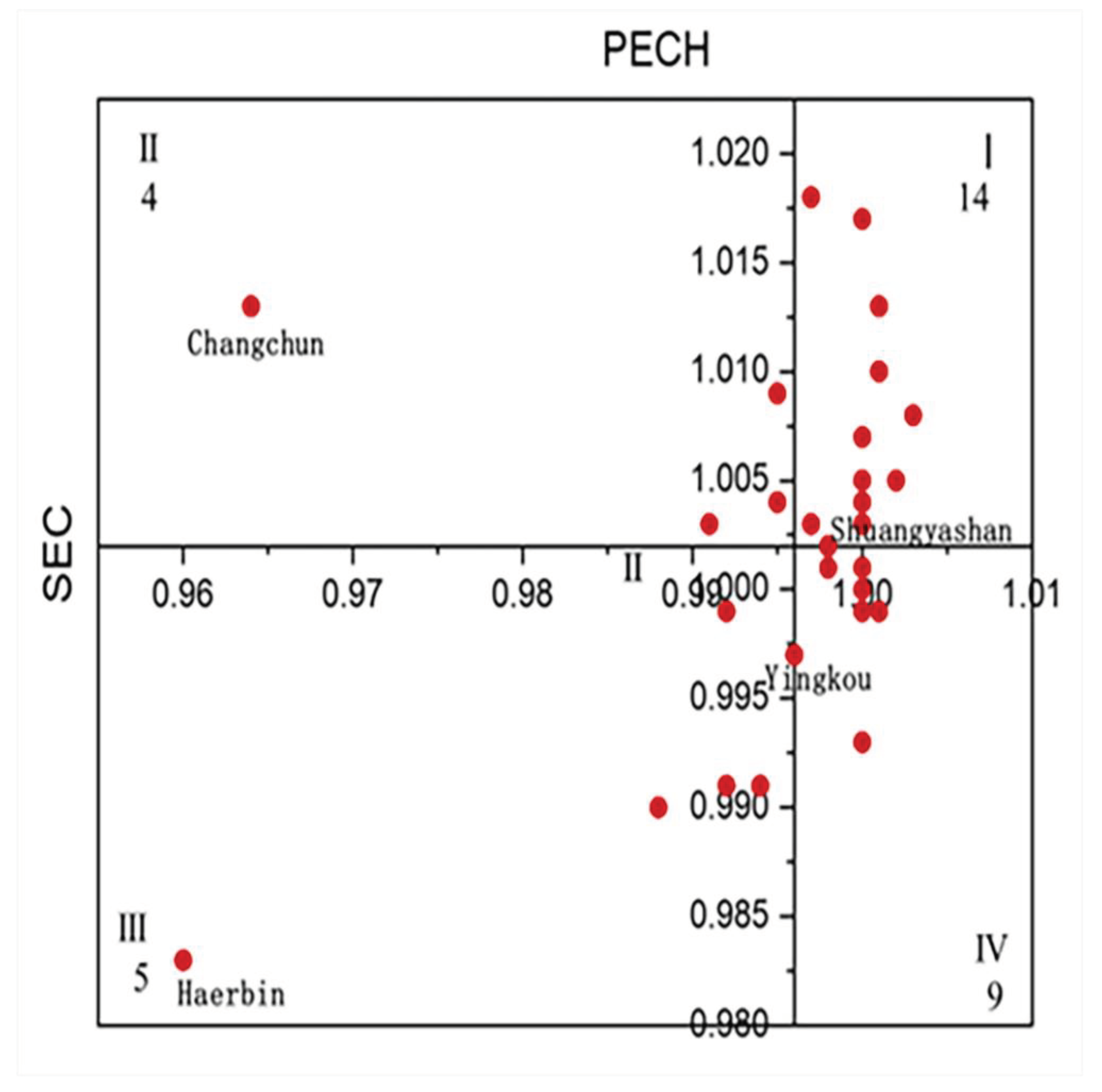
4.3. Spatial Autocorrelation Analysis of Water Resource Utilization Efficiency
|
Years Index |
2004 | 2007 | 2011 |
| Moran's I | 0.223 | 0.196 | 0.153 |
| Z Score | 2.161 | 2.074 | 1.584 |
| P Value | 0.027** | 0.037** | 0.069* |
| Note: * Distinguish significance, * * * P<0.001, indicating very significant ** P<0.05 is more significant, * P<0.1 is more significant | |||
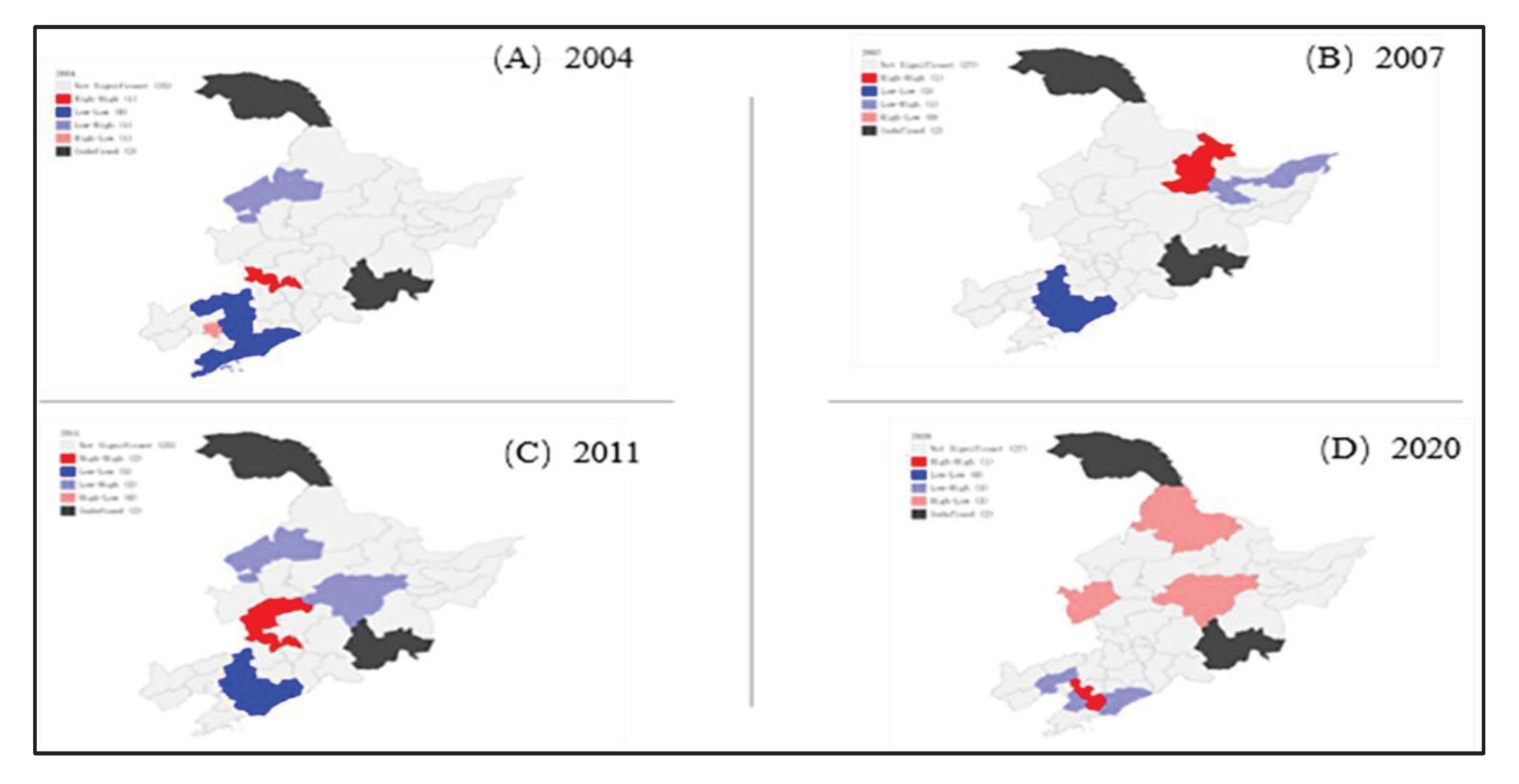
5. Analysis of Influencing Factors
| Model 1 | Model 2 | ||||||||
| Et_Vt | Coef. | Std. Err. | z | P>z | Et_Vt | Coef. | Std. Err. | Z | P>z |
| GDP growth rate |
-0.31*** | 0.09 | -3.31 | 0.001 | GDP growth rate |
-0.07 | 0.11 | -0.68 | 0.49 |
| Industrial structure |
0.02 | 0.02 | 1.04 | 0.297 | Industrial structure |
0.04** | 0.02 | 2.84 | 0.01 |
| Open to the outside world |
0.00 | 0.00 | 0.29 | 0.768 | Open to the outside world |
0.00 | 0.00 | -0.80 | 0.43 |
| Educational level | 0.12 | 0.82 | 0.14 | 0.886 | Educational level | 3.86*** | 1.30 | 2.98 | 0.00 |
| Socioeconomic expenditures |
-0.18 | 0.18 | -0.98 | 0.328 | Socioeconomic expenditures |
-1.07*** | 0.20 | -5.23 | 0.00 |
| _cons | 0.81 | 0.09 | 9.02 | 0 | _cons | 0.52 | 0.15 | 3.50 | 0.00 |
| Note: * Distinguishes significance, ***P<0.001 for highly significant, **P<0.05 for more significant, *P<0.1 for more significant. | |||||||||
6. Conclusions
Author Contributions
References
- Q. F. Wu. Attribution Analysis of Terrestrial Water Storage and Estimating Groundwater Recharge at Regional Scale on The Loess Plateau [D]. Northwest Agriculture and Forestry University of Science and Technology.
- F. Gong ; L.T. Du ; C. Meng ; Y. Dan ; L.Wang ; Q. Q. Zheng ; L. L. Ma ; Characteristics of water use efficiency in terrestrial ecosystems and its influence factors in Ningxia Province[J]. Journal of Ecology, 2019(24 vo 39): 9068-9078. [CrossRef]
- C. Z. Sun , K. Jiang , L. S. Zhao , Study on the measurement and spatial pattern of green efficiency of water resources in China[J]. Journal of Natural Resources,2017,32(12):1999-2011. [CrossRef]
- H. Q. Zhang , Y. L. Huang ; T. Qin , J. Li , Green efficiency of industrial water resources considering unexpected output based on SBM-Tobit regression model [J]. Water Economics, 2019(05 vo 37): 35-40+47+78-79.
- Z. Zhou , H. Wu , P. Song , Measuring the Resource and Environmental Efficiency of Industrial Water Consumptionin China: A Non-Radial Directional Distance Function[J]. Journal of Cleaner Production, 2019(240): 118169. [CrossRef]
- L. Yue , Y. Y. Lei , Construction of Spatial Linked Network of Green Water Resource Efficiency in the Yellow River Basin and its Evolutionary Factors [J/OL]. Journal of Northwest Normal University (Social Science Edition), 2022(02 vo 59): 62-74.
- T. Deng , D. Wang , Y. Yang , et al. Shrinking cities in growing China: Did high speed rail further aggravate urban shrinkage? [J/OL]. Cities, 2019,210-219. [CrossRef]
- G. S. Yang, Q. H. Xie, Study on the spatial and temporal differentiation of green water resources efficiency in the Yangtze River Economic Belt [J]. Yangtze River Basin Resources and Environment, 2019(02 vo 28): 349-358.
- M. F. Gao ,H. Yu , J. Zheng. Research on green water efficiency and spatial drivers in the Yellow River Basin[J]. Ecological Economy,2020,36(07):44-50+209.
- Li Jian,Xie Heng. Analysis of green water utilization efficiency and its spatial and temporal differences and drivers in Beijing-Tianjin-Hebei[J]. Journal of Water Resources and Water Engineering,2021,32(06):10-18.
- Sun Qian. Research on spatial and temporal changes of water resources in Xinjiang based on GRACE and GLDAS [D]. Xinjiang University,2016.
- LUO Zhicai,LI Qiong,ZHONG Bo. Inversion of water storage changes in the Heihe River Basin using GRACE time-varying gravity field[J]. Journal of Surveying and Mapping,2012,41(05):676-681.
- Tiwari V M, Wahr J and Swenson S. Dwindling groundwater resources in northern India[J]. from satellite gravity observations, 2009(36): L18401. [CrossRef]
- LI Qiong,LUO Zhicai,ZHONG Bo et al. Detection of water storage changes in arid land of southwest China in 2010 using GRACE time-varying gravity field[J]. Geophysical Journal,2013,56(06):1843-1849.
- SONG Guojun,HE Wei. Benchmarking of water resource utilization efficiency in Chinese cities[J]. Resource Science,2014,36(12):2569-2577.
- CHEN Yanping,LIU Chang. Water resource utilization efficiency and its spatial and temporal differentiation characteristics in the Yellow River Basin[J]. Statistics and Decision Making,2022,38(08):62-66.
- SUN Caizhi,XIE Wei,JIANG Nan et al. Spatial and temporal variability of the relative efficiency of water resources utilization in China and the factors affecting it[J]. Economic Geography,2010,30(11):1878-1884.
- Jin Wu,Yang Wei. Analysis of the current situation and rational utilization of water resources in northeast China[J]. Heilongjiang Science and Technology Information,2015(28):182.
- Wang Jiaze. Study on the Measurement of Sustainable Development Level of Water Resources in Northeast China[D]. Jilin University of Finance and Economics,2020.
- Cui L, Zhang C, Luo Z, et al. Using the Local Drought Data and GRACE/GRACE-FO Data to Characterize the Drought Events in Mainland China from 2002 to 2020[J/OL]. Applied Sciences-Basel, 2021, 11(20): 9594. [CrossRef]
- ZHOU Zejiong,HU Jianhui. Research on performance evaluation of low-carbon economic development based on Super-SBM model[J]. Resource Science,2013,35(12):2457-2466.
- Tone K. A slacks-based measure of efficiency in data envelopment analysis[J/OL]. European Journal of Operational Research, 2001, 130(3): 498-509. [CrossRef]
- Tone K. A slacks-based measure of superefficiency in data envelopment analysis[J/OL]. European Journal of Operational Research, 2002, 143(1): 32-41. [CrossRef]
- Liu K, Xue Y, Lan Y, et al. Agricultural Water Utilization Efficiency in China: Evaluation, Spatial Differences, and Related Factors[J/OL]. Water, 2022, 14(5). [CrossRef]
- SUN Caizhi,MA Qifei,ZHAO Liangshi. Research on the change of green efficiency of water resources in China based on SBM-Malmquist productivity index model[J]. Resource Science,2018,40(05):993-1005. [CrossRef]
- Wang S, Zhou L, Wang H, et al. Water use efficiency and its influencing factors in China: based on the data envelopment analysis (dea)-tobit model[J]. 2019.
- Kumar K S, Anandraj P, Sreelatha K, et al. Monthly and Seasonal Drought Characterization Using GRACE-Based Groundwater Drought Index and Its Link to Teleconnections across South Indian River Basins[J]. Climate, 2021, 9(4): 56. oi.org/10.3390/cli9040056.
- Liu K, Yang G liang, Yang D gui. Industrial water-use efficiency in China: Regional heterogeneity and incentives identification[J/OL]. Journal of Cleaner Production, 2020, 258: 120828. [CrossRef]
- Wang S, Gao S, Huang Y, et al. Spatiotemporal evolution of urban carbon emission performance in China and prediction of future trends[J]. Journal of Geographical Sciences, 2020, 30(5): 18.
- Zhong K, Wang Y, Pei J, et al. Super efficiency SBM-DEA and neural network for performance evaluation[J/OL]. Information Processing & Management, 2021, 58(6): 102728. [CrossRef]
- ZHANG Zhaofang,SHEN Juqin,HE Weijun et al. "Evaluation of regional water resources utilization efficiency in Belt and Road China - based on superefficient DEA-Malmquist-Tobit method[J]. Journal of Hohai University (Philosophy and Social Science Edition),2018,20(04):60-66+92-93.
- Feng L , Wang L , Zhou W .Research on the Impact of Environmental Regulation on Enterprise Innovation from the Perspective of Official Communication[J].Discrete Dynamics in Nature and Society, 2021.
- Wang S, Zhou L, Wang H, et al. Water Use Efficiency and Its Influencing Factors in China: Based on the Data Envelopment Analysis (DEA)-Tobit Model[J/OL]. Water, 2018, 10(7): 832. [CrossRef]
- QIAN Wenjing,HE Canfei. Study on regional differences in China's water resources utilization efficiency and influencing factors[J]. China Population-Resources and Environment,2011,21(02):54-60.
- BAI Yazong, SUN Fuli, HUANG Linglang et al. Assessment of water resources utilization efficiency and regional differences in China[J]. Environmental Protection Science,2014,40(05):1-7.
- REN Yufen,SU Xiaowan,HE Yuxiao et al. Urban water utilization efficiency and influencing factors in China's eco-geographical zones[J]. Journal of Ecology,2020,40(18):6459-6471.
- YANG Chao,WU Lijun. Differential analysis of water resources utilization efficiency in Chinese cities - Empirical evidence based on panel data of 286 prefecture-level and above cities[J]. People's Yangtze River,2020,51(08):104-110.
- ZHAO Liangshi, SUN Caizhi, ZHENG Defeng. Measurement of interprovincial water utilization efficiency and spatial spillover effects in China[J]. Journal of Geography,2014,69(01):121-133.
| system of indicators | formula | unit |
| Level of economic development | GDP growth rate in municipal districts | % |
| industrial structure | Share of secondary sector in GDP/weight of tertiary sector in GDP | % |
| Socioeconomic expenditures | General public budget expenditure/GDP | % |
| technological progress | Number of patents granted | each |
| open to the outside world | Export trade volume/GDP share | % |
| educational level | General primary and secondary school enrolment per 10,000 population | Tens of thousands/tens of thousands |
| Year (years) | 2003 | 2004 | 2005 | 2006 | 2007 | 2008 | 2009 | 2010 | 2011 | Total |
| Number of valid values (in pieces) | 16 | 16 | 11 | 10 | 3 | 6 | 22 | 13 | 12 | 248 |
| Year (years) | 2012 | 2013 | 2014 | 2015 | 2016 | 2017 | 2018 | 2019 | 2020 | |
| Number of valid values (in pieces) | 13 | 12 | 14 | 18 | 17 | 14 | 18 | 17 | 16 |
Disclaimer/Publisher’s Note: The statements, opinions and data contained in all publications are solely those of the individual author(s) and contributor(s) and not of MDPI and/or the editor(s). MDPI and/or the editor(s) disclaim responsibility for any injury to people or property resulting from any ideas, methods, instructions or products referred to in the content. |
© 2024 by the authors. Licensee MDPI, Basel, Switzerland. This article is an open access article distributed under the terms and conditions of the Creative Commons Attribution (CC BY) license (http://creativecommons.org/licenses/by/4.0/).





